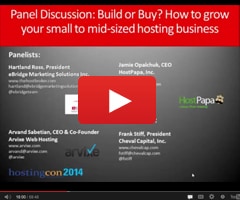Should You Build or Buy Your Business Growth?
“How do I grow my business?”
This (or a close variant) might be one of the most common questions I get asked by clients and those looking for help. I wish that I had an easy answer to that, but as you know, growing a business is an undertaking that depends wholly on your business model and your industry, amongst a myriad of other factors.
With that said however, there are generally two options at your disposal when looking to grow a business – build or buy.
As a business owner considering growth strategies, you must evaluate carefully the implications when deciding whether it’s better to build the business through organic growth or to grow the customer base through a merger or acquisition.
Let’s take a look at 5 considerations to keep in mind when choosing between the build or buy route.
1. The Math
Look at the cost benefits of acquiring a customer versus opting for organic growth.
- Acquisition multiples vary but for an average figure, you can assume 1X the annual recurring revenue from revenue sources that aren’t involving a 3rd party, such as domains and SSL certificates for example.
- The cost to acquire customers through organic growth varies significantly based on the type of hosting (such as shared, VPS, Dedicated, Cloud, Managed etc.), the country in which you are marketing, and the tactic to acquire the customer (referrals, search marketing, social media, trade shows, display advertising, affiliates etc.). However you can assume that for all but the very warm sources such as referrals and the pay for performance sources such as affiliates, you can expect to pay more than 1X for organic growth.
2. Distraction
As they say, time is money, so it’s important to keep in mind resources and efficiencies and to stay focused.
- Organic growth lets you focus on specific sectors or products and cherry pick where your customers are coming from including industry, geography, product type, OS, etc. This could allow you to be more efficient with supporting systems such as billing software, vendors, and human resources.
- When looking at acquisitions, honestly evaluate whether you have the time and human resources to do the due diligence. Even if you do, you may decide after many tens of hours that the deal is not right for you and you therefore need to stop pursuing it. You then need to do this all over again for another deal or be able to review multiple deals simultaneously. You may also incur hard costs through retaining professional services of an accountant, attorney, or other consultants. Is your business prepared for these realities?
- Thinking about taking on both build and buy at once? Tread carefully and consider workload issues. If you go this route, would you be doing both poorly? Your business has finite resources, so you need to be sure that you maximize their use and don’t dilute your efforts by spreading yourself too thinly.
3. Customer Retention
A major risk factor to consider when ramping up a business is how will customers be impacted?
- For the acquisition route, this is of particular concern if you don’t have the background to support the acquired customers. If you already offer Minecraft hosting for example, adding 5000 new accounts will require some integration but likely no radical shift. If, however, you have never offered this service, the learning curve could be steep and costly. Generally in an acquisition, the customer base being acquired doesn’t get split up, or at least not beyond OS or hosting type, so you have little control over other variables like geographic location of the customers, the customer profile etc., meaning your customers may become more diverse.
- With organic growth, the growth is incremental and controlled, mitigating some of the risks. The customer profile is likely more homogenous meaning that you can replicate your existing structure to support these new customers without obtaining specialized skill sets, equipment, network infrastructure etc.
4. Effects on the Sale of Your Business
Consider your exit strategy when looking at acquisitions.
- If as a result of acquisitions, the customer base becomes very heterogeneous, there may be a negative impact on an ultimate exit multiple. Let’s consider a few examples of how this could play out:
-
- You could be in a situation where a newly purchased customer base hasn’t been around long enough to show a history of renewals – this is particularly true for multi year accounts.
-
- If there are multiple brands purchased all paying different amounts for similar services, this can become complicated to support and keep separate so as to prevent cannibalization (ie. the customers paying more will convert to the less expensive brand assuming a similar offering).
-
- If growth is only occurring due to acquired customers, typically this means that customer churn isn’t going to be offset from organic growth. This translates into a buyer purchasing a decreasing asset, which will affect the valuation.
- There are, however, benefits to acquisitions with respect to EBITDA in that there would be no marketing expenses. Keep in mind that revenue tends to play a more important role than profitability for consolidators since the existing cost structure is unlikely to be relevant to them in their environment.
5. Completing a Transaction
This is not a complete discussion on doing due diligence and the steps involved in closing a deal however I wanted to bring up a few considerations and answer some questions when it comes to completing that transaction to finish things off.
- The challenge – how hard is it? There are generally more buyers than sellers for a straight forward hosting customer base. If the customer base is more niche, this would limit interest. A transaction takes time with possible hard costs, as mentioned above.
- Due diligence – requires a clear process. Random questions in no logical order will reduce the seller’s confidence, require more time to complete DD and most importantly will likely mean you will overlook critical aspects of a transaction.
- Typical structure – normally a deal is done with some larger amount upfront (50% to 80%) with the remaining portion coming over time (30 to 90 days for smaller deals and up to a few years for larger ones). Having said this, there are many formats which include revenue shares (earn outs), different valuations and payouts for different product lines.
- Financing – At first glance, growing organically may appear not to make sense however there are other factors to consider. In addition to the points above, you have to have access to capital and the sellers that are running attractive and well run operations will typically receive multiple offers. This means that you need to move quickly and have access to financing. Organic growth on the other hand can often be self financed and could be more manageable to support.
So to sum up…
Organic growth offers…
- The ability to focus your efforts on specific target markets
- Controlled growth
- Can be self-financed
An acquisition requires…
- The resources to devote to the process
- Background and infrastructure to manage new customers
- No marketing expenses
- Access to capital
When deciding whether to go for an acquisition or to take the route of growing organically or possibly to leverage both strategies, there are various factors to consider. Ultimately, it comes down to looking at your particular situation to select the option best suited to your organization.
Build or Buy? How to Grow Your Small to Mid-sized Hosting Business
This session took place at HostingCon Global 2014. For more information about HostingCon, go to www.hostingcon.com.
Looking for some expertise to help guide your decision? Contact us today! Want to go the acquisition route for your hosting business? Visit The Host Broker for our comprehensive list of opportunities and businesses for sale.
Posted September 24, 2014
Categories: eBridge Marketing Solutions' Blog,
General Business
Tags: acquisition, b2b marketing, organic growth

